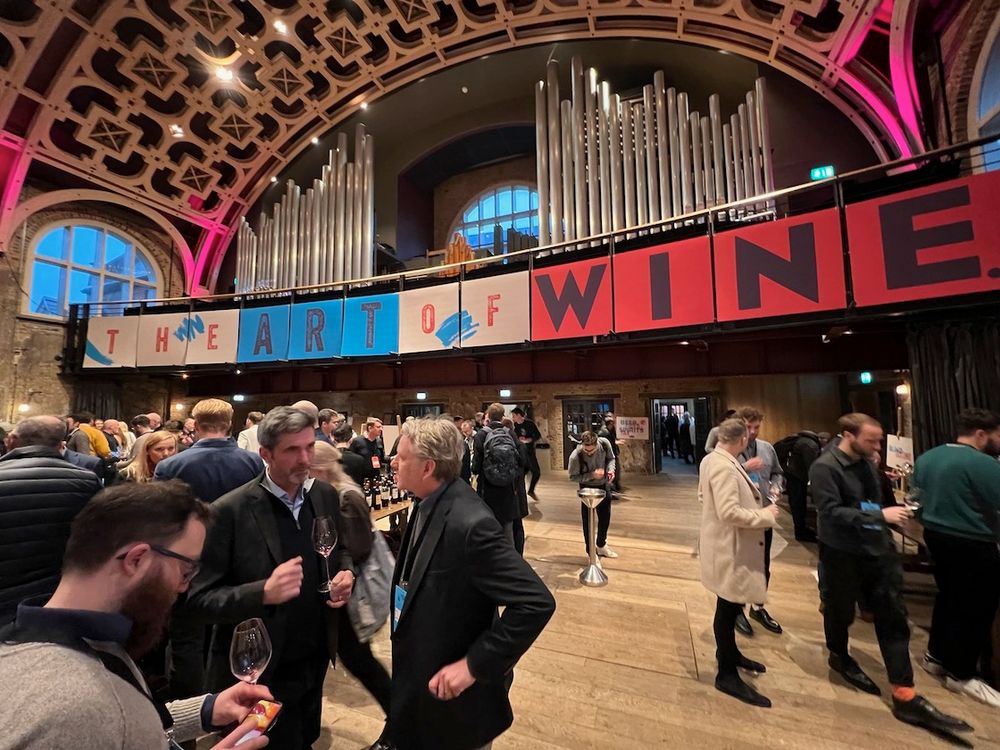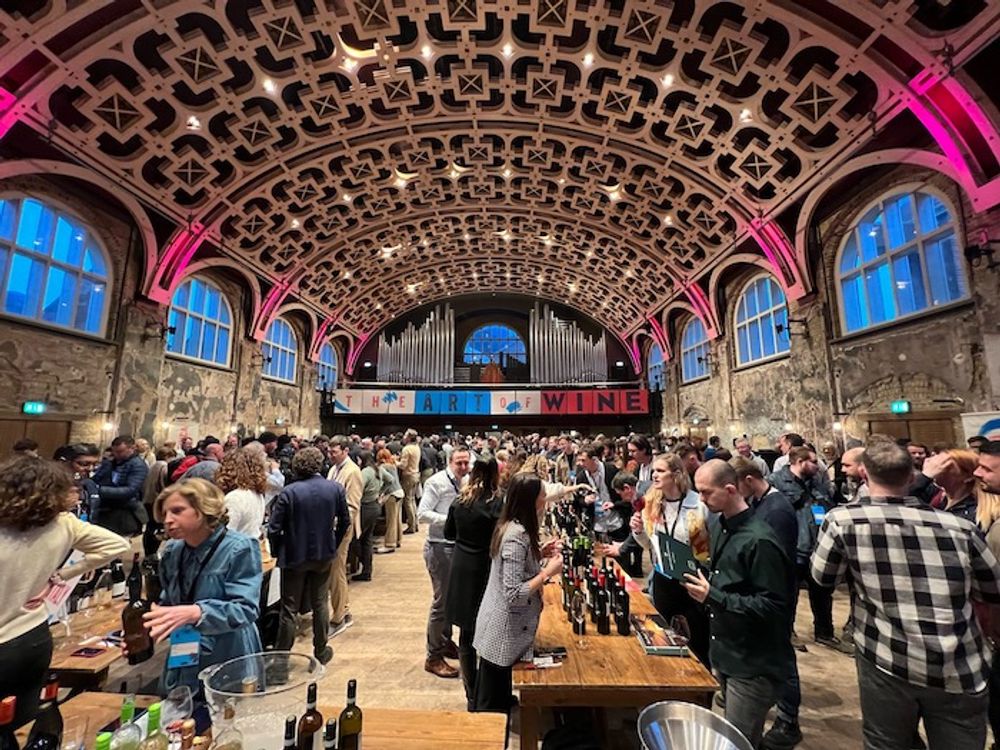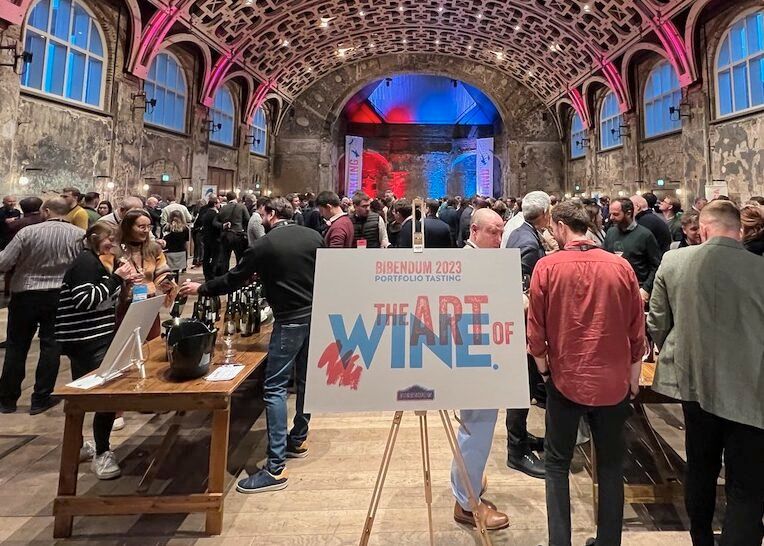“Whereas before, upward price pressures tended to be vintage-related, now they reflect such things as rising transportation costs and, of course, inflation,” says group wine trading director, Harriet Kininmonth at Bibendum’s Art of Wine event.

Bibendum’s Art of Wine, January 25, 2023: like all your parties rolled into one
There were times during Bibendum’s Art of Wine portfolio tasting – with more than 350 wines and side shows like bottle painting and cork modelling, designed to show, well, wine’s arty side – that this huge event felt less like a tasting and more like all the parties you’ve ever been to rolled into one. OK, maybe not Everything, Everywhere, All At Once (no alternate realities or people with hot dog fingers!) but it was full on, with attendees from all over across the UK trade and an impressive range of wines.
And the venue, the Battersea Arts Centre, in the heart of my old stomping ground on Lavender Hill, was a good choice, so much so that I wondered why it hasn’t been chosen for tastings before. With stripped walls, a bar to show Bibendum’s non-vinous offerings, wooden tables for the wines, and cool lighting, this felt like hipster heaven. Crowded and intense hipster heaven. With some truly exciting wines, as you might expect, from some of the industry’s best producers.
But as has been written extensively elsewhere, these are tough times for the on-trade in particular and many businesses hang in the balance – with prices rising and real incomes falling, going out for dinner isn’t what it was, and wine is inevitably one of those things people save money on. The off trade is also suffering as prices continue to rise.
“These are tough times and there’s no escaping that,” says Harriet Kininmonth, wine trading director. “Whereas before, upward price pressures tended to be vintage-related, now they reflect such things as rising transportation costs and of course inflation. And they are across the board.”
Justin Keay’s Top 10 wines from the tasting
Thankfully for consumers, Bibendum seems to have responded to this challenging outlook by broadening its offering and emphasising value. This was evident in its ‘new wines’ table, heavy on generally well priced wines from Spain, Italy and France. Amongst the Spanish contingent, the wines from Ramirez de Ganuza were most enjoyable including of course the flagship Gran Riserva Tempranillo Graciano 2012, showing well and benefiting from 36 months in oak; the Riserva 2014 – 26 months in oak – was impressive too, fresh and well balanced with a long spicy finish.
My favourite of the bunch though – making my Favourite Ten list – was the Blanco Riserva 2020, 100% Viura, fresh and rounded and benefiting from 8 months in French oak. White Rioja really has come a long way and this is a fine example.
Amongst the Italians two very decent Vermintini from Cantina Mesa in Sardinia caught my eye, notably the Primo Vermintino di Sardegna 2021, a great, fresh expression of the variety, 100% stainless steel, very good value. However, it is the Ca Maiol Prestige Lugana 2021 that makes my Number 2 wine – a great expression of Trebbiano from this historic producer, one of the first in the Lugana DOC; very smooth, light oak and exceptional value at around £14 a bottle trade.
Proving they are not one to allow a popular trend to pass them by, Bibendum has finally added a range of Greek wines to their list. Amongst them are some entry level wines from the Peloponnese – much needed in this fast-growing category – but sadly not shown in the tasting because they were stuck in customs (Brexit strikes again). However, there was the 2021 Assyrtiko from Peloponnese-based produced Rouvalis (very different style from typical Santorini Assyrtiko) alongside the same producer’s spritzy Asprolithi PDO Patra Roditis 2021, high acidity and a great aperitif wine and the red Tsigelio PGI 2021, a moreish, slightly austere and dry Mavrodaphne- all well priced at around £15 a bottle trade.
But it was the Santorini Assyrtiko 2020 from that island’s iconic cooperative Santo Wines that makes Number 3 of my list; deliciously saline and complex, a great expression of this variety, to be tasted alongside the fabulously sweet but delicious Vin Santo 2016, a lovely, aged blend of Assyrtiko and Aidani. Santo is one of the pioneers of Assyrtiko and on this evidence its wines really have never been better.
The Sparkling wine table at the far end of the Great Hall had a scrum around it throughout the tasting, with prosecco, champagne and English sparklers all competing for attention. After struggling to the front I discovered two very different Italian fizzy wines for my Top 10. Wine 4 from Veneto is Bottega Poeti Ancestral Spumante 2020, a sort of ‘anti-Prosecco’; very dry and slightly cloudy, this blend of Glera and 10% Moscato is made by the ancestral method which allows fermentation in the bottle rather than the tank. Lightly sparkling, this has apple and pear on the surprisingly complex palate. Great value at just £11 trade.
Next up at 5 a superb Trento-Doc from Ferrari, the Perle Nero Riserva 2015, a wonderfully rich – five years on the lees – sparkling Pinot Nero, with suggestions of raspberry and quince on the palate, very long finish. Very moreish.

Gérard Bertrand’s international sales director, Yann Bourigault with THAT guitar
Throughout the tasting there was a gaggle of activity in the middle of the French aisle and I soon saw why: punters were lining up to be in with a chance to win an electric guitar signed by Jon Bon Jovi. Sadly the winner wasn’t destined to be me but I discovered two other ‘winners’ at the table showing Gérard Bertrand’s wines. The first, which makes my 6th choice, was Hampton Water Rosé 2022, a delicious and charming blend of Grenache, Cinsault, Syrah and Mourvèdre in this joint venture between the rockstar, his son Jesse and Gérard Bertrand. Each of the varieties are lightly pressed and then fermented separately to produce a surprisingly rich and complex pink wine. One of the best rock/pop star wines I’ve tasted (sorry Kylie, sorry Sting) and well deserving both of the 90 points Wine Spectator gave it and its £15 on-trade price tag. “A happy wine” said a fellow taster – I’ll go with that.
My wine 7, Gerard Bertrand’s Clos du Temple Rosé, 2021, Languedoc Cabrières is made with the same grape varieties as Hampton Water with the addition of Viognier but comes with the moniker and price tag (£169 trade) of ‘Best rose wine in the world’. I wouldn’t want to necessarily dispute that- made from grapes grown in Cabrieres, in Languedoc AOP which are then aged in new French oak for six months, this biodynamic wine is damn fine, fresh but also complex, with great length. Really classy but also really enjoyable.

To New Zealand for my eighth wine, Neudorf Rosie’s Block Chardonnay 2018, a perfectly balanced, really well made wine from Nelson, with a warm, sunny palate with suggestions of peach, apricot and vanilla. New Zealand has been trying hard to break away from being associated purely with Sauvignon Blanc and much has been written about the quality of its Chardonnay – this is a truly great example at a good price (around £24 trade) that shows the Kiwis can give the Burgundians a proper run for their money.
Another Chardonnay makes wine 9, but from the far side of the world from Neudorf. The Checkmate Attack Chardonnay 2015 from British Columbia’s Okanagan Valley is produced by the Mission Hill group, one of the Canadian wine industry’s pioneers; incredibly fine and intensely aromatic with buttery vanilla notes supporting the peach and apricot palate, this is made in tiny volumes – just 4000 bottles – but well worth seeing out.
And for wine 10, we’re off to Puklavec Family Wines in Slovenia. Its Seven Numbers Furmint 2021 shows that although Hungary is home to Furmint, other Central European countries – including Austria, Slovakia and Slovenia – can also make great expressions of the variety. This is surprisingly full-bodied, with lots of fruit character but also quite spicy, with a very long finish that shows both the versatility of the variety (which can also produce lean wines with high acidity as well as, of course, the famous sweet Tokaji Aszu) and the skill of the winemaker. A great take on a great variety.

Footnote…
One small gripe… with the UK wine trade mega keen to flag its green credentials, many importers are now opting not to publish physical tasting books. No one is keener to save the planet than me, but at Bibendum’s Art of Wine I realised this approach has a downside – because taking serious notes is made more laborious, many people just don’t bother and just seem to want to party. And what a party it was.
Bibendum is a commercial partner of The Buyer. To discover more about them click here.
































